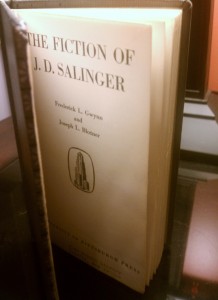MLA Citation:
Frederick Gwynn and Joseph Blotner’s slender volume of commentary addresses the bulk of Salinger’s oeuvre. The body of the book is divided into three convenient sections and seven sections in total comprise the work.
First Paragraph:
“For the future historian, the most significant fact about American literary culture of the Post-War period may be that whereas young readers of the Inter-War period knew intimately the work of a goodly number of coeval writers (Hemingway, Fitzgerald, Dos Passos, Wolfe, Sinclair Lewis, for example), the only Post-War fiction unanimously approved by contemporary literate American youth consists of about five hundred pages by Jerome David Salinger.”
Summary:

Introduction
The introductory section details the prevailing critical responses to Salinger’s work. They briefly describe the critical stance of critics Heiserman and Miler, David Stevenson, Ihab Hassan, Leslie Fiedler, Donald Barr, William Wiegand, and Maxwell Geismar, though they do not engage with their theoretical stances in the introduction.
Gwynn and Blotner also identify “For Esme-With Love and Squalor” the “high point of Salinger’s art” (for more information, see the “For Esme…” readers guide).
The Long Debut: The Apprentice Period (1940-1948)
This section discusses the twenty or so stories that appeared largely in magazines such as Collier’s and The Saturday Evening Post, but also in a handful of others such as Cosmopolitan and Good Housekeeping). Gwynn and Blotner describe these as being of five types, “The Short Short Stories,” “The Lonely Girl Characterizations,” “The Destroyed Artist Melodramas,” “The Marriage in Wartime Group,” and “The Caulfield Stories.”
All His F-a-c-u-l-t-i-e-s Intact: The Classic Period (1948-1951)
In this section the authors discuss five of the stories included in Nine Stories,, and Salinger’s only novel, The Catcher in the Rye. They include attention to the most successful elements of “A Perfect Day for Bananafish,” “Uncle Wiggly in Connecticut,” “Just Before the War with the Eskimos,” “The Laughing Man,” “Down at the Dinghy,” and of course, The Catcher in the Rye.
Seen Through the Glass Family, Darkly: Religion Through Satire
This section looks briefly at “Pretty Mouth and Green My Eyes” calling it a brief “tour de force.” There is a longer section devoted to “De Daumier-Smith’s Blue Period” and “Teddy” which are both considered very successful attempts labeled as “subtle” and “original”. The section concludes with focused attention on the Glass family stories, most notably, on “Raise High the Roofbeam, Carpenters,” “Franny,” and “Zooey.”
Conclusion: The Way of a Pilgrim
The conclusion circles back to the authors’ speculation at the beginning and attempts to address the popularity of Salinger’s fiction. Gwynn and Blotner conclude:
Salinger’s career — one discovers on examination — has been a slowly maturing and then suddenly bloating process: it was bogged down in trivial magazine tales for a half-dozen years, was apparently released by the experience of WWII, came to a height with a half-dozen stories and a novel in the 1948-1951 period, and has been declining recently as its noble attempt to adapt a habitual satiric style to almost purely religious themes has become self-conscious. (53)
* The remainig two sections are devoted to footnotes and an excellent bibliography that includes both primary and secondary sources.
The book is a must for anyone conducting serious research on Salinger since it provides commentary on both well-known and lesser-known pieces. It is also useful for an exploration of criticism contemporary to Salinger.

Photo taken by Ralph Thompson of Faulkner in Rouss Hall (UVA) with (l to r) Joseph Blotner, Frederick Gwynn, unidentified man. May 15, 1957. [Print# 0166; Digitization# 000005733_0009]. Faulkner at Virginia, © 2010 Rector and Visitors of the University of Virginia; Author Stephen Railton.
